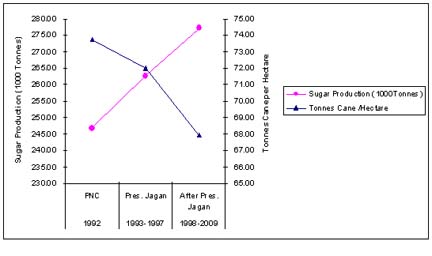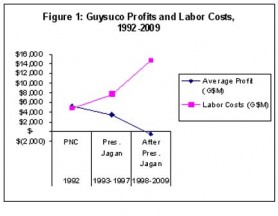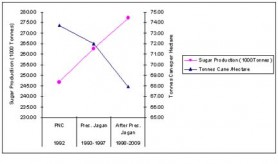Dear Editor,
The stranglehold the sugar unions (GAWU and NAACIE) have on GuySuCo is an indication of who is in charge of sugar in Guyana and particularly the Skeldon White-Elephant. This letter, however, is not about the unions or about the expected achievements or non-achievements of Skeldon; it is not even about the delayed promise of President Jagdeo to get involved to correct the problems at the factory. Instead, this letter is about an analysis of the expanding losses and declining efficiency in sugar production in Guyana. I will show with evidence extracted from GuySuCo Annual Reports for 2001 and 2009 that since President Cheddi Jagan’s death, GuySuCo has been in a ‘free-fall’ with the PPP/C government in full command of GuySuCo without any interference, not even for one day, by any political opposition party or an investigative press. This has been a journey of crass mismanagement and a case of poor oversight by an inept Board of Directors. More troubling is the fact that GuySuCo engages in a zero-sum game in which the PPP/C government has ceded power to the unions, rather than standing firm and focusing on the interest of all Guyanese.
In 1992 when the PNC lost the elections, GuySuCo made a profit before taxes and levy of $5.4 billion, with the total labour costs for the sugar industry being $4.9 billion. The following year with the new PPP/C government, a distinctive change in policy took place as profits were progressively reduced at the expense of increasing wage costs for workers. Mr. Robert Persaud, the Information Liaison to President Jagan, confirmed such an approach in a response Mr. Ravi Dev, Leader of ROAR. Specifically, Mr. Persaud wrote that the PPP/C Government was responsible for ensuring the rapid advancement of sugar workers’ benefits and working conditions, adding that employment cost which was $2.7 billion in 1992 was now over $10.0 billion (SN article, `The sugar-coated playing fields of GuySuCo’, July 11, 2003). This new policy was further intensified after President Jagan’s death in 1997 when the whole process of wage setting and cost control seem to have broken down leading to the current disputes with unions clamouring and winning generous compensation packages from a dying industry. Profits during President Jagan’s period in office (1992-1997) averaged $3.6 billion per year before taxes and levy, with an average wage cost of $7.8 billion per year. After President’s Jagan’s death profits turned to losses, averaging $0.4 billion per year, with average wage cost increasing from $7.8 billion to G$14.6 billion per year during the period 1998-2009. Figure 1 below captures this experience as it shows the widening gap between wage costs and company losses.
It is clear, therefore, that after President Jagan’s death, GuySuCo was on a destructive glide path of exploding losses and cash flow shortages that had to be covered by taxpayers funding from the Consolidated Fund. This was done and is still being done on a regular basis through the Treasury.
The counter argument to losses often expressed by GuySuCo’s Board of Directors and Management is that production is higher than what it was under the PNC government. Whereas production under the PNC government was only 246.9 thousand tonnes in 1992, it increased to an average of 262.7 thousand tonnes during the Presidency of President Jagan, increasing further to an average of 277.00 thousand tonnes during the period 1998-2009. The response to this argument, however, is that while these production figures are accurate, the more important claim is that industry efficiency was decreasing. In fact, wage incentives for workers were tied to higher output figures without any relationship to efficiency yield factors. Specifically, while output was increasing, the tonnes of cane per hectare moved downwards from 73.75 in 1992 to an average of 67.92 tonnes per hectare during the period 1988-2009 (Figure 2). In other words, declining cane per hectare is a strong signal of increasing costs, but this issue apparently was never addressed in wage talks.
Figure 2: Sugar Production and Tonnes of Cane per Hectare
Additionally, tonnes of sugar per hectare have also declined, signalling greater inefficiencies and higher production costs that have financial viability concerns for GuySuCo. Higher output from a technology that is becoming less efficient over time is a direct indicator of the declining technical skills of the teams in the field and factory. In the field, declining efficiency could be related to insufficient inputs, poor husbandry or poorly managed infrastructure. In the factory, it could be related to factory breakdowns, the loss of a skilled work force, and delays in cane processing. Recently, it was announced that production in 2010 is expected to be lower than the average of 277,000 tonnes and much closer to the 250,000 tonnes, due to union strikes, or bad weather. One implication of this fall in output could be the importation of sugar for the domestic market as was the case in 2009.
Along with the expected sugar price cuts, the end of European special preferences, high staff-turn over, unexpected rains and numerous strikes, it is obvious that GuySuCo is a loss making enterprise that is unable to breakeven, even with subsidies from the Treasury. It is buried in debt and it does not pay taxes. Besides, GuySuCo is a welfare agency for a selected few who consume a far greater share of the total output in the form of worker-benefits at the expense of GuySuCo long-run financial viability. It is time the government do the right thing and fix GuySuCo; and more specifically, it is time the Skeldon White Elephant be fixed or closed. The next move is the President’s.
Yours faithfully,
C. Kenrick Hunte



